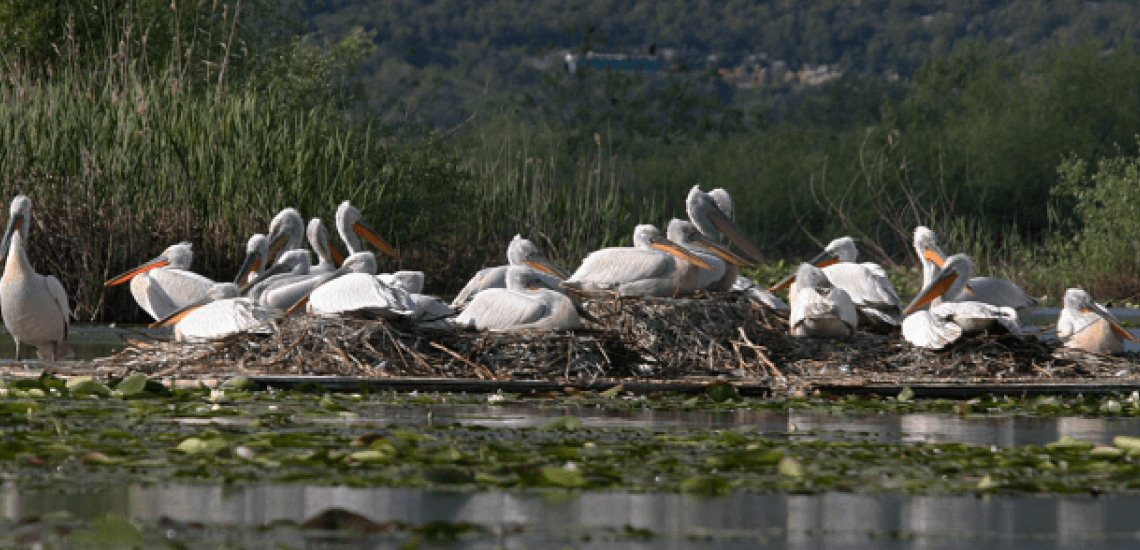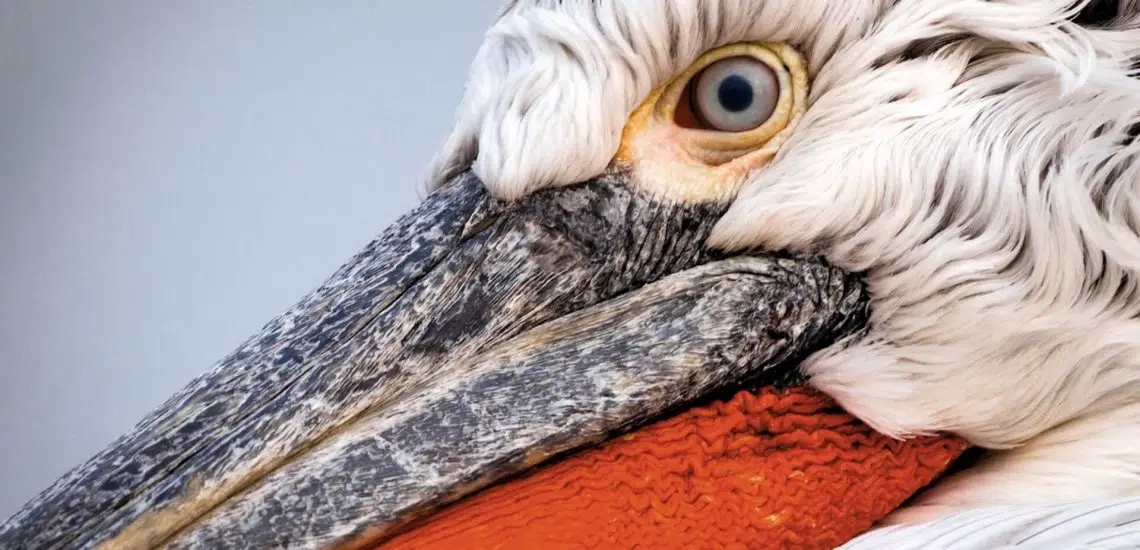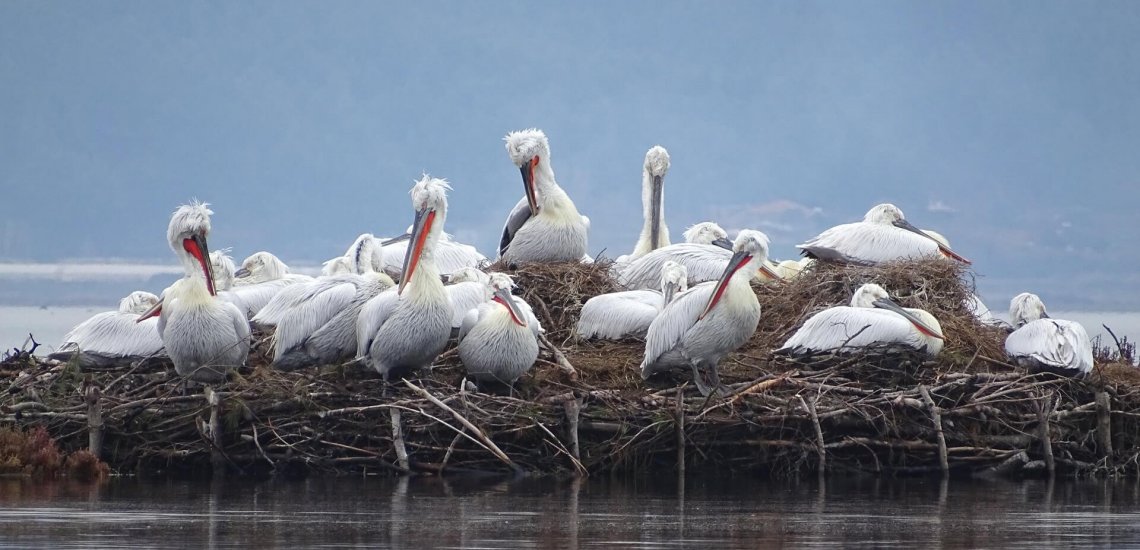Pelican hotline
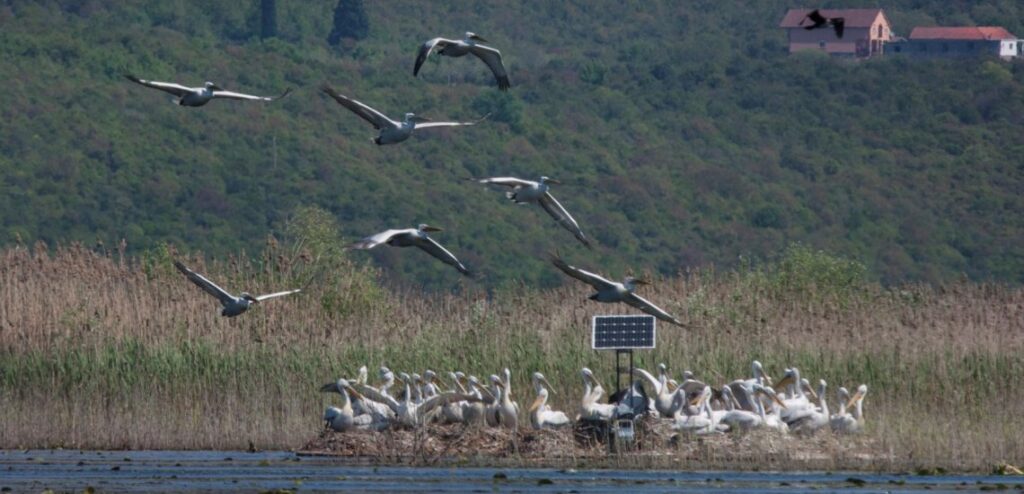
The gentle giants at Lake Skadar, between Albania and Montenegro, are now video-monitored 24hrs a day and threats can be addressed in real-time. With local communities embracing all things pelican, and nesting success increasing, the time of the pelican is coming again.
By Shaun Hurrell
Header image: Dalmatian Pelicans on one of the project’s nesting rafts. Photo: © Natural History Museum of Montenegro
On a lake that borders Montenegro and Albania, cold rain, strong wind and waves are like romantic music for Dalmatian Pelicans Pelecanus crispus. The beginning of December marks the start of the breeding season for Pelicans on Lake Skadar, and with every splash of rain, these huge birds run and dance around on floating wooden rafts, bobbing their heads, with giant beaks pointed straight up to the thunderclouds.
Unbeknownst to the flirting pelicans, their displays are being watched. You see, despite their huge size, Dalmatian Pelicans are very susceptible to disturbance and its global population is declining. So, night and day, conservationists are observing them from afar, having set up a brand new video-monitoring system – as part of a regional programme led by Noé Conservation supported by the Critical Ecosystem Partnership Fund (CEPF), MAVA and other donors.
“Having only watched previously from distant hills and boats, now we could finally get answers for so many questions,” said Bjanka Prakljacic from Noé Conservation, who has spent hours observing and listening to the birds nest on their specially-constructed nesting rafts, as part of a multi-partnered project to conserve the pelicans on Lake Skadar. “What we saw on the live feed was just how vulnerable this big bird is.”
Having only watched previously from distant hills and boats, now we could finally get answers for so many questions,
BJANKA PRAKLJACIC, NOÉ CONSERVATION
Since last year’s drama with video monitoring and the fate of the entire colony resting on one raft, this year the Public Enterprise for National Parks of Montenegro and Natural History Museum of Montenegro (NHM) added two additional rafts for the pelicans.
Dalmatian Pelicans have been declining since the 1970s on Lake Skadar. Fluctuations in weather conditions, causing flooding of nests, and human disturbance have contributed greatly to this, and they are classified as globally Vulnerable by BirdLife International (for the IUCN Red List).
The new rafts eliminate the problem of flooded nests, and the new video equipment allows the team to keep an eye on the pelicans and potential threats from disturbance, also giving insight into their frantic courting and nesting behaviors.
“It is truly amazing how those big beaks can move so gently and controlled to place a reed stalk in a growing nest,” says Bjanka.
However, it turns out fear is a big thing for these gentle giants, as the biggest storm turbulence proved too much the colony – meaning at one point the team had to watch pelicans timidly circle the bobbing rafts. Painfully close, but leaving some bare white eggs unincubated.
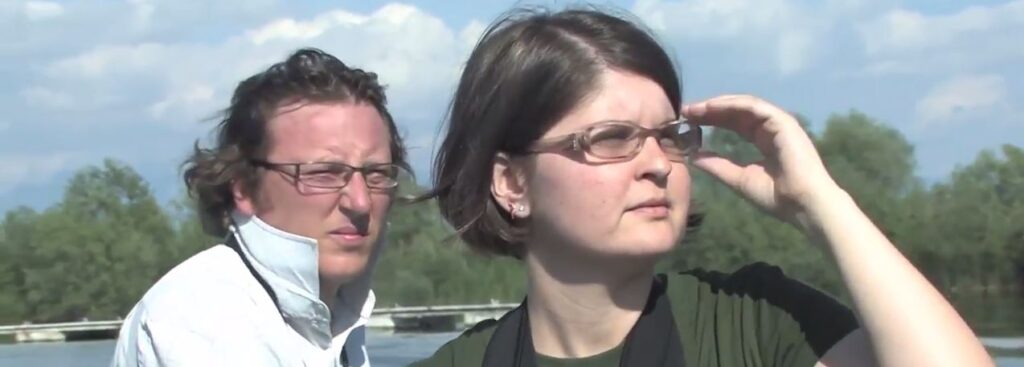
“On the bright side,” says Bjanka, “if the colony was formed on a natural island, the nests would have been completely lost to the Skadar’s angry waters. This way the pelicans quickly returned to the nests and replaced lost eggs.” With the storms over, the fear of disturbance by nearby fishermen still remained, but it seems fishermen are starting to respect the colony. “The live video monitoring became a warning system,” says Bjanka. “As soon as the pelicans even slightly raised their heads in fear, Noé picked up the phone to call the National Park authorities, who dispersed rangers as quickly as possible.”
This ‘pelican hotline’ quickly became a ‘pelican patrol’, with a special ranger patrol assigned to the nesting area. The team also worked with the police, performed night patrols, and the Center for Protection and Research of Birds in Montenegro (CZIP; BirdLife Partner) spent over 200 hours rain or shine monitoring the colony from a hill, but had less and less incidents to report.
One emergency was the recovery of a weak juvenile pelican that had strayed too far from the colony and sustained injuries from entanglement in fishing nets, but Noé and CZIP were able to administer veterinary care.
“We could count pelican disturbance cases on our fingers, and that is a great success,” concluded Andrej Vizi, ornithologist from the Natural History Museum of Montenegro. “But, historically, the pelican colony existed here and has done for almost two centuries, telling us that the coexistence with fishermen can be sustained.”
“To prevent further problems, such as night-time disturbance, the solution lies in the community,” Aleksandar Perovic from CZIP explains: “When illegal activities happen it is already too late; we need to work to prevent them. We need to work with people that share their livelihoods with the pelicans.”
Nela Dubak from Public Enterprise for National Parks of Montenegro says: “With projects, like the one funded by CEPF, we are focusing on sustainable tourism. We always worked with local communities and now we have chance to work with people in direct contact with pelicans.”
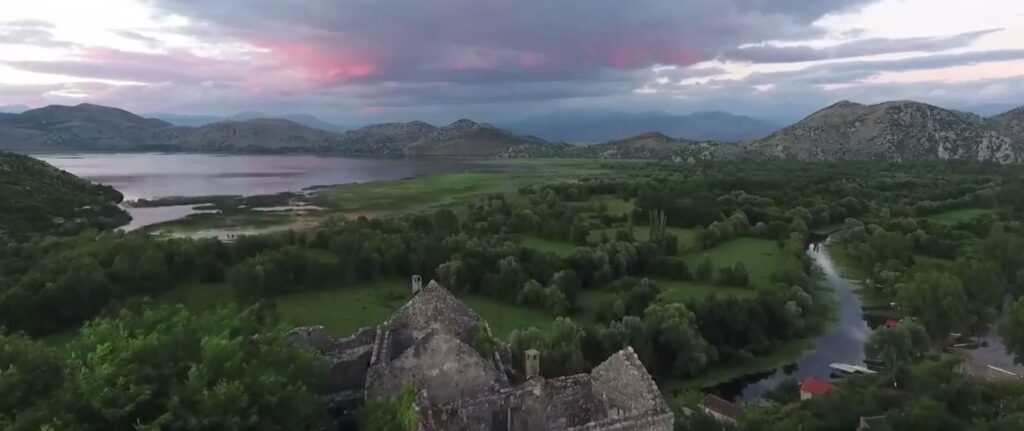
Andrej Vizi agrees: “The local community have started to recognise the pelicans as an asset and not a nuisance. With a fast developing eco-tourism industry at Skadar Lake, the pelicans become even more of an important icon.”
In fact, Lake Skadar National Park is slowly becoming pelican-crazy. CEPF supported ‘Pelican Day’ in Montenegro, and development of the concept of ‘Pelican villages’ that sees the community embracing all things pelican: an information centre, research and ranger station, educational trail, fishermen conducting non-invasive boat tours, and an observation point on the hill for tourists.
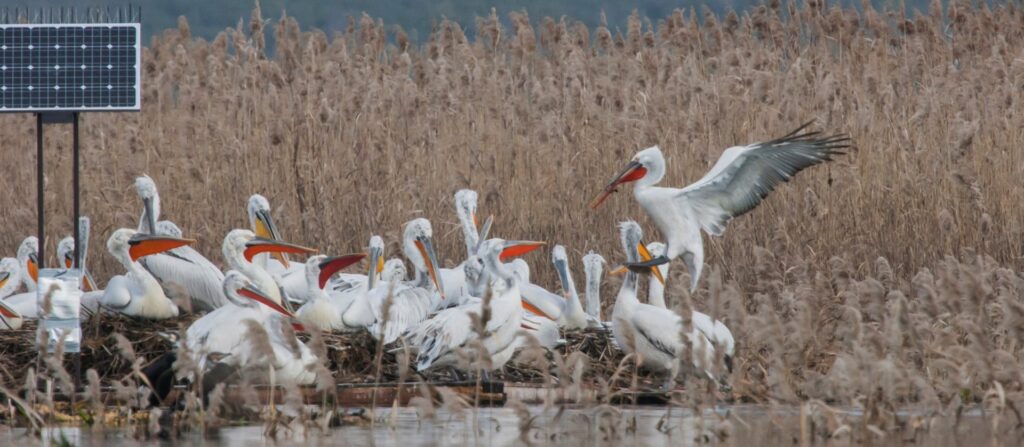
The project has also extended beyond Lake Skadar, monitoring all relevant wetlands in Montenegro as the part of the first South-East European Pelican census on 7th May 2016 (including Albania, Bulgaria, Greece, Macedonia, Montenegro, Romania and Turkey) on more than 80 wetlands across the region, organised by the Society for the Protection of Prespa in collaboration with the Hellenic Ornithological Society (HOS; BirdLife in Greece).
“In Montenegro we counted 146 pelicans not including the chicks on the rafts, and there are still nesting,” says Bjanka. “With 40 chicks so far counted by the NHM, we are again approaching the ‘golden years’ of pelican numbers on Skadar Lake (which was about 200 in the late 1970s).”
The number of Pelican breeding pairs and newborn chicks has been increased year by year since the programme started in 2013. Upon leaving the nesting rafts, the pelicans have been seen exploring the far corners of the lake. This is where they leave the watchful eye of the conservationists’ video system, and are in the hands of the local community. This project gives great hope that the population will continue to increase.
“The time of the pelican is coming again,” says Bjanka.
BirdLife International – including its Middle East office and the BirdLife Partners DOPPS/BirdLife Slovenia and LPO (Ligue pour la Protection des Oiseaux, BirdLife in France) – is providing the Regional Implementation Team (RIT) for the Critical Ecosystem Partnership Fund (CEPF) in the Mediterranean Basin Biodiversity Hotspot (CEPF Med).
Find out more at www.birdlife.org/cepf-med.

CEPF project title: Conservation of Pelicans, a Key Biodiversity Species of Skadar Lake
Grantee: Noé Conservation. Partners: Public Enterprise National Parks of Montenegro; National Park Skadar Lake; Natural History Museum of Montenegro; CZIP – Center for Protection and Research of Birds of Montenegro; Tour du Valat; EuroNature; Association for the Protection of Aquatic Wildlife Albania.
This CEPF project is part of – and complimented by – a wider project, funded by the MAVA Foundation, called “Wetland Management and Dalmatian Pelican Conservation in the Mediterranean Basin” covering Albania (Karavasta), Greece (Kerkini Lake) and Montenegro (Skadar Lake).
